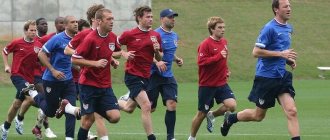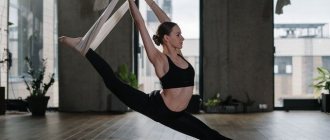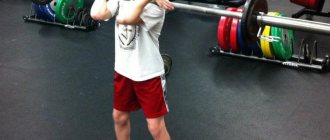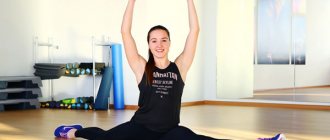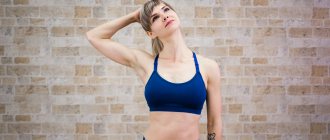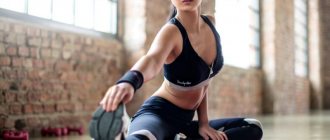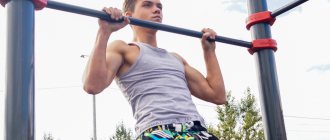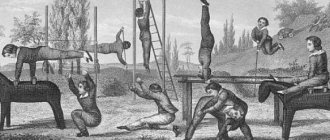The dream of many parents is for their child to do the splits. And the kids themselves often want to learn how to perform this beautiful exercise. In addition to the aesthetic component, twine is also beneficial for the body. It makes the baby's muscles strong and flexible, improves joint mobility and coordination of movements, which reduces the risk of the child getting injured when falling. But we know that children and falls are practically synonymous.
Classification of stretching for children
According to the method and nature of the impact, exercises are divided into four main groups.
- Static. Gradual stretching of one or more muscles at a slow pace.
- Dynamic. Stretching a specific muscle group at an accelerated pace.
- Ballistic. Swing movements performed with high amplitude and extreme range.
- Proprioceptive. Stimulation of neuromuscular activity through alternate relaxation and contraction. Designed to work antagonist muscles.
Where to start stretching for splits
Any workout should begin with a warm-up. Despite the fact that children's muscles have increased plasticity, they still need pre-warming.
Any active exercises are perfect for this: running, jumping, dancing. Anything that will make the young gymnast actively move and his muscles work. But remember that our task is not to exhaust the child, but to prepare him for further stretching. The optimal time for warming up is 5 – 10 minutes. Come up with your own exciting method. This could be a set of movements to your favorite song or some kind of game. This approach will make your classes more interesting.
We also pay attention to the fact that you should start training with a “basic complex”. We will present it below. These exercises prepare the body to fully stretch the legs. Basic exercises for children are very similar to those performed by adults. But they need to be done with greater caution. The child cannot yet correctly assess the capabilities of his body, and this can lead to injury.
Methodology
Before stretching, you should warm up your muscles with a light warm-up in the form of running, squats, jumping rope, swinging your arms and legs. The duration of the warm-up is determined individually, according to the age and physical characteristics of the child, but no more than 15-20 minutes.
Each stretching exercise is carried out in 4 stages:
- initial position,
- stretching,
- exit from the stretch,
- interval pause.
During execution, the pulse should be smooth, well-filled, and breathing should be calm. The movement begins with inhalation. Exhale slowly while stretching. The main indicator of positive dynamics is the absence of pain during and after classes.
Features of children's twine
Muscle and connective tissues in children are softer and more pliable for various types of manipulation. Therefore, making twine is much easier for children than for us adults. But, despite this feature, we should not forget that their muscles are not plasticine. You need to gradually put your baby on the splits. You should also remember about some psychological nuances. Not all children want to stretch and waste their time of carefree play on exercise.
Therefore, think carefully about your child’s motivation and how your classes will be held. If you decide to send your child to a specialized sports section or club, make sure the qualifications of the teacher and familiarize yourself with the conditions in which you will have to practice. Home training is received with great enthusiasm by many children. This is the time to spend with your parents. It is important that the child enjoys studying. Otherwise, you will expect childish rebellion and the absence of any results.
Before you start stretching, you need to decide on the type of twine: longitudinal or transverse. The set of exercises that will make up a deep stretching complex will depend on the type of splits. Longitudinal twine is much easier to perform. Try to master this particular exercise first.
Another nuance that is worth paying attention to is that the child, at the initial stage, cannot stretch on his own. He needs help, both physical and psychological. Therefore, it is best to do all the exercises together, insuring the baby and making sure that they are performed correctly. This will not only allow you to achieve the desired results faster, but also avoid unnecessary injuries.
Age characteristics
There are no age restrictions for children's stretching. Moreover, the sooner a child starts regular classes, the more benefits they will bring.
The exception is specialized exercises intended for sports and choreography. Professional-type stretching is carried out only under the supervision of an experienced trainer.
3-4 years
How to stretch a child of primary preschool age? Up to 4 years of age, it is advisable to conduct classes in a playful way - this will form and consolidate the interest necessary for systematic training.
The warm-up phase begins with jumping rope. Among other things, a jump rope is an excellent tool for developing coordination of movements. This is followed by 8-10 (no more) squats. It is recommended to finish the warm-up by bending forward on straight legs.
- “Butterfly flies” is an exercise for eversion and stretching of the hip joints. While sitting, pull your legs towards your pelvis and bring your feet together. Make smooth “swings” with your arms and bent legs 5-6 times.
- “A butterfly sits on a leaf” - in the same starting position, gently press your hands on your knees, pressing them to the floor.
- “The butterfly is sleeping” - without changing the position of your legs, stretch your arms forward and press your body to the floor. You can help your child by lightly pressing his knees to the floor. If the backrest is a wheel, try gently pressing it to level it.
- "Frog". Lie on your stomach, turn your head to the side and rest on your arms bent at the elbows. Tighten your legs, bending them at the knees, as high as possible. Hold the pose for 10-20 seconds.
- "Swing". Lying on your stomach, bend your legs. Wrap your palms tightly around your ankles and slowly lift your legs (pull them towards your head), carefully bend over (5-10 seconds).
5-6 years
In children aged 5 and 6 years, the joint apparatus, subject to regular training, is already fully formed and the required level of elasticity has been achieved. Therefore, the complex includes more complex stretches, including longitudinal and transverse splits.
- Working out triceps and biceps. Stand up straight. Bringing your right hand over your shoulder, reach the area between the shoulder blades, while simultaneously pressing the elbow of your right hand with the other hand. Repeat 5-6 times, changing hands.
- Pectoral muscles. Pull your hands back and lock them together. Slightly arching, raise your joined hands to the highest possible point.
- Stretching the muscles of the back and lower back. Get on your knees. Sit down, pressing your heels to your pelvis. Stretching your arms forward, bend over, trying to reach the maximum point of tension.
- Working out the hip muscles. Attach an elastic bandage or gymnastic elastic tape to the feet. Lie on your back. Raise your legs using the tape to a right angle.
- Quadriceps. In a standing position, bend your leg. Holding your foot with your hand, pull up to the limit.
- Calf muscles. Toe stand. Fixation in lifting for 10 seconds.
- Feet. When sitting, your back is straight. Pull your feet with your toes towards you. The basic complex also includes complicated exercises such as “butterfly”, “frog”, “swing”, etc.
7-8 years
The ages of 7 years and 8 years are characterized by an increase in the mobility of the bone joints of the skeleton. The joint apparatus is formed, the ligaments have acquired the necessary degree of elasticity. Starting from this period, the training plan includes exercises from all four groups of stretches from static to proprioceptive.
Leg-split
We have a detailed article on how to teach a child to do the splits. Graduality and consistency are the main conditions for effective learning. At home, it is better to start by mastering the technique of longitudinal twine.
- In a sitting position, extend your legs forward and spread to the sides. Keeping your back straight, bend deeply forward. Wrap your hands around the top of your foot and hold the pose for 10 seconds. Straighten up.
- Stand up, spread your legs wider than shoulder width and do several springing actions. The body is straight.
- Feet wider than shoulders, toes pointing to the sides. Lean forward and place your hands on the floor. Fixation in a pose – 10 seconds.
Attention! Classes are held only after warming up! The nature of movements, quantity and degree of difficulty vary depending on the age and level of physical fitness of the child.
Games to develop flexibility in primary school children
The game method occupies a special place in the development of plasticity in children of primary school age. It is already quite difficult to capture the attention of 8-10 year old schoolchildren, but the game and competitive elements will cause them real delight. In addition, the game contributes to the most effective consolidation of exercises.
The list of the most popular games is presented in the table.
| Name of the game | What you will need | Progress of the game |
| Jumping over a barrier | Gymnastic stick | Each player takes turns taking the stick by the ends and tries to jump over it without letting go of his hands. |
| Confusion | Participants only (up to 10-15 people) | A presenter is selected and sent to another room. Meanwhile, the players, holding hands, begin to get tangled in a ball. The presenter’s task is to unravel the tangle without releasing the players’ hands. |
| Camel racing | Two or three teams of players | Participants, pretending to be camels, must walk a certain distance. To do this, they must bend over, clasp their ankles with their palms, straighten their legs and arch their back. |
| Bridge | Pair of players | The first participant must stand in the bridge, and the second must crawl under it without touching it. The couple whose bridge lasts the longest wins. |
| Wave | At least 10 participants | Players stand in a circle with their hands clasped. Next, they should depict waves with their hands, and the leader, located in the center of the circle, should try to dive under one of the waves without touching it. If he does this, he takes the place of one of the players. |
| Tumbler | Sports mat | A “tumbler” is selected, who sits on the mat, crosses her legs in Turkish style and rests her hands on her hips. The remaining players must take turns approaching the tumbler and try to knock it onto the mat. "Tumbler", in turn, must resist. |
| boats | Multiple commands | The essence of the game is to go the distance, pretending to be boats. To do this, you need to sit on the floor, stretch your arms to the sides and move forward by bending and straightening your legs. |
Independent studies
Stretching for children also provides undoubted benefits to those who are not involved in regular sports or choreography. The advantages of doing simple exercises at home for beginners:
- Prevention of injuries.
- Improving coordination of movements.
- Prevention and/or treatment of scoliosis.
- Strengthening the musculoskeletal system.
- Regulating the functioning of the genitourinary system.
- Improving the functions of the digestive organs.
- Development of the respiratory organs.
It is better to schedule classes at home to coincide with morning exercises - this will make it easier for your child to instill this useful skill. Beginners are recommended to start with simple exercises in the form of bending, swinging and stretching. Over time, difficulty and intensity can be increased.
Important! Stretching can be included in home exercises only after a medical examination. Since in the presence of an intervertebral hernia, sprain and other serious health problems, it can cause harm to the body.
The benefits of children's stretching
This article deals exclusively with the amateur type of load. When classes with a child are carried out for his harmonious physical and psychological development. Thanks to such training, children’s backs are strengthened, their posture is leveled, and all muscle groups are toned.
Stretching to the splits helps relieve psychological fatigue and tension. This is especially important for schoolchildren who are overloaded with tasks today. Relieving tonic tension during training helps stimulate brain function.
Thanks to regular exercises for 20 minutes, the child will begin to absorb information more easily, anxiety will decrease, and immunity will improve.
Children's split stretch
Children master the splits much faster and easier. Their body is still developing, and favorably perceives this kind of load. The main thing is not to overdo it. Remember that it is very easy to overdo it. But eliminating the consequences is the opposite. It is not without reason that professional gymnasts have many diseases that are associated specifically with stretching.
Pay attention to how the child reacts to a particular exercise. If you see that he is in pain, reduce the impact. If your baby doesn’t do a certain movement willingly, try changing it to another exercise. Don't be afraid to experiment. It is very important that training is enjoyable. Only in this case will the child return to them and achieve good results.
Important Terms
Let's consider what a child should be able to do before starting classes, and what requirements he must meet. There are several of them:
- no medical contraindications;
- age 5-7 years;
- desire to engage;
- good stretching;
- the ability to do bends and swings, linger at the end point for 5-10 seconds.
Only when these conditions are met can you begin further training.
